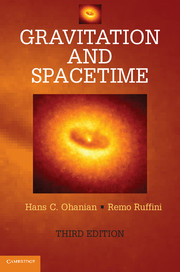Book contents
- Frontmatter
- Contents
- Preface
- Constants
- Notation
- 1 Newton's gravitational theory
- 2 The formalism of special relativity
- 3 The linear approximation
- 4 Applications of the linear approximation
- 5 Gravitational waves
- 6 Riemannian geometry
- 7 Einstein's gravitational theory
- 8 Black holes and gravitational collapse
- 9 Cosmology
- 10 The early universe
- Appendix Variational principle and energy-momentum tensor
- Answers to even-numbered problems
- Index
- References
6 - Riemannian geometry
Published online by Cambridge University Press: 05 April 2013
- Frontmatter
- Contents
- Preface
- Constants
- Notation
- 1 Newton's gravitational theory
- 2 The formalism of special relativity
- 3 The linear approximation
- 4 Applications of the linear approximation
- 5 Gravitational waves
- 6 Riemannian geometry
- 7 Einstein's gravitational theory
- 8 Black holes and gravitational collapse
- 9 Cosmology
- 10 The early universe
- Appendix Variational principle and energy-momentum tensor
- Answers to even-numbered problems
- Index
- References
Summary
Mathematics? Einstein did not know any mathematics.
Werner Heisenberg to Remo RuffiniThe linear tensor theory of gravitation that we developed by analogy with electrodynamics started out as the theory of a tensor field in a flat spacetime background. The geometric interpretation of this tensor field emerged only as an afterthought. However, the analysis of spacetime measurements (with clocks for time measurements and also for distance, by means of the radar-ranging procedure) has shown us that the flat spacetime background is purely fictitious – in a gravitational field, the real geometry measured by our instruments is the geometry of a curved spacetime, that is, the geometry of a Riemannian spacetime.
Mathematically, a Riemannian space is a differentiable manifold endowed with a topological structure and a geometric structure. In the discussion of the geometric structure of a curved space we must make a distinction between the affine geometry and the metric geometry. These two kinds of geometries correspond to two different ways in which we can ascertain the curvature of a space. One way is by examination of the behavior of parallel line segments, or parallel vectors. For example, on the surface of a sphere, we can readily detect the curvature by transporting a vector around a closed path, always keeping the vector as parallel to itself as possible. Figure 6.1 shows what happens if we parallel-transport a vector around a “triangular” path on the sphere. The final vector differs in direction from the initial vector, whereas on a flat surface the final vector would not differ. Such changes in a vector produced by parallel transport characterize the affine geometry (the word affine means connected and refers to how parallels at different places are connected, or related).
- Type
- Chapter
- Information
- Gravitation and Spacetime , pp. 221 - 274Publisher: Cambridge University PressPrint publication year: 2013

